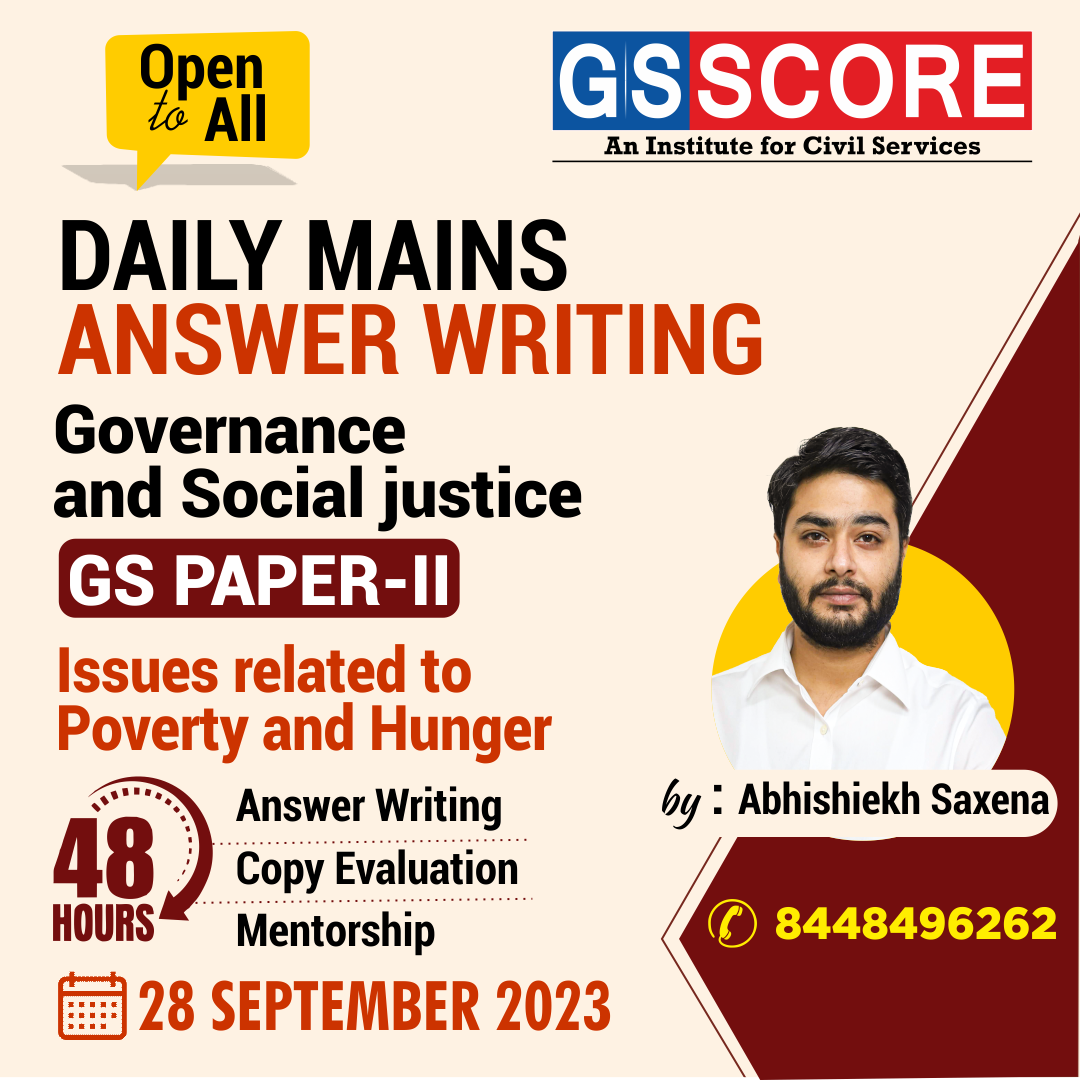


Instruction:
- There will be 2 questions carrying the First Question is-10 marks Write your answers in 150 words and the Second Question is-15 marks Write your answers in 250 words.
- Any page left blank in the answer-book must be crossed out clearly.
- Evaluated Copy will be re-uploaded on the same thread after 2 days of uploading the copy.
- Discussion of the question and one to one answer improvement session of evaluated copies will be conducted through Google Meet with concerned faculty. You will be informed via mail or SMS for the discussion.
Question #1. “Poverty in India is not merely the absence of economic resources, rather the combined deprivation of social and political opportunities.” Analyse the statement. 10 marks (150 words)
Question #2. While India has made significant strides in achieving food security since independence, nutrition security still remains a distant dream. Examine the statement with the help of substantial evidences. 15 marks (250 words)
(Examiner will pay special attention to the candidate's grasp of his/her material, its relevance to the subject chosen, and to his/ her ability to think constructively and to present his/her ideas concisely, logically and effectively).
STEPS & INSTRUCTIONS for uploading the answers
Step 1 - The Question for the day is provided below these instructions. It will be available at 7:00 AM.
Step 2 - Uploading of Answers : Write the answer in A4 Sheet leaving proper margins for comments and feedback and upload the PDF in MY ACCOUNT section. Click on the option of SUBMIT COPY to upload the PDF.
Step 3 - Deadline for Uploading Answers: The students shall upload their answers by 7:00 PM in the evening same day. The first 50 copies will be evaluated.
Step 4 - Feedback : Mentors will give their feedback for the answers uploaded. For more personalised feedback, join our telegram channel by clicking on the link https://t.me/mains_answer_writing_cse . A one-to-one session will be conducted with the faculty after copy evaluation in 72 Hrs.
Model Answer
Question #1. “Poverty in India is not merely the absence of economic resources, rather the combined deprivation of social and political opportunities.” Analyse the statement. 10 marks (150 words)
Approach:
- Briefly explain poverty. Give a brief description of poverty in India, e.g., mentioning the BPL estimate ( 50 words)
- Enumerate the social and political deprivation responsible for poverty ( 80 words)
- Conclude ( 20 words)
Hints:
Unlike the commonly held notion of poverty being restricted to income, poverty is rather a multidimensional phenomenon. It encompasses the various deprivations experienced by poor people in their daily lives – such as health, education, living standards, political power, and quality of work, among others.
Description of poverty in India
- India has made momentous progress in reducing multi-dimensional poverty, according to estimates from the 2018 Global Multidimensional Poverty Index (MPI) released today by the United Nations Development Programme (UNDP) and the Oxford Poverty and Human Development Initiative (OPHI). The incidence of multidimensional poverty has almost halved between 2005/6 and 2015/16, climbing down to 27.5 percent from 54.7 percent.
- Among South Asian countries, only Maldives has a lower headcount ratio than India at 1.9 percent, with Nepal (35.3 percent), Bangladesh (41.1 percent), and Pakistan (43.9) having higher incidences of multidimensional poverty. Though the traditionally disadvantaged groups – across states, castes, religions, and ages –are still the poorest, they have also experienced the biggest reductions in MPI through the decade, showing that they have been “catching up”. This is in line with global trends, where deeper progress among the poorest groups is reflected in the global MPI being cut by half.
- Despite the massive gains made in reducing multidimensional poverty, 364 million Indians continue to experience acute deprivations in health, nutrition, schooling and sanitation. Just over one in four multi-dimensionally poor people in India are under ten years of age.
Poverty as a manifestation of social and political deprivation:
- Caste: Scheduled Castes and Tribes constitute half of the total "poor, deprived households", a BPL pilot survey had revealed. The communities are not just poor but also score high on kuchcha housing, illiteracy among adults, homelessness, destitution, landlessness with agricultural wages as their main source of income.
- Gender: Women across the globe face poverty in terms of unpaid care work and comparatively lower wages. Feminization of povertyis a phenomenon referring to the widening gap between women and men caught in a sequence of economic deprivation and scarcity.
- Rural-urban divide: As per National Sample Survey Organisation (NSSO) survey, India has 354.68 million poor out of which, around 278 million are in rural areas. Around 34 per cent of the rural population lives below the poverty line while in case of urban areas it is 21 per cent.
- Economic policies of the government since independence and New Economic Policy, 1991, in particular, have mostly enriched and expanded the coffers of the upper class given their domination in society and economy and unbroken power hold whatever may have been the party in power. As a consequence, the gap between the rich and the poor has been widening and the latter are getting more and more deprived in terms of access to common resources and lack of opportunities.
- Poor governance, corruption and substandard public service delivery is often cited as the prime cause of poverty especially when rights approach is being emphasized upon. Lack of political opportunities is a prime cause for poverty in many parts of the world.
- Absence of political power deprives a person of popular representation essential for voicing concerns of the deprived section. Political persecution and related violence is also a problem worldwide.
Conclusion:
Good employment opportunities supplemented with social equality and political empowerment is essential for overcoming the problem of poverty and to achieve the first sustainable development goal of eradicating poverty in all its forms.
Question #2. While India has made significant strides in achieving food security since independence, nutrition security still remains a distant dream. Examine the statement with the help of substantial evidences. 15 marks (250 words)
Approach:
- Define nutrition security and India’s status in it. ( 20 words)
- Examine the need for nutrition security. ( 50 words)
- Suggest measures and way forward to improve the scenario- such as food fortification , biofortification , dietary diversity, etc. ( 60 words)
- Conclusion ( 20 words)
Hints:
While food security is the availability and the access of food to all people, nutrition security demands the intake of a wide range of foods which provides the essentially needed nutrients. Since independence, significant achievements have been made in India with regard to food production and security by means of Green Revolution and Public Distribution System thus solving much of the hunger problem.
However, the Food and Nutrition Security Analysis report, 2019 suggests high prevalence of malnutrition, pointing fingers towards the incomplete goal of nutrition security.
Nutrition insecurity can be gauged from following indicators:
- 4 % of children under age five years were stunted as per NFHS-4. It is the highest number of stunted children in the world (46.8 million children), representing one-third of the global total of stunted children under the age of five.
- In 2015-16, 21% of children under age five years were wasted, accounting for almost 31 % of all the world’s wasted children.
- According to a latest UNICEF report, over 80 per cent adolescents in India suffer from "hidden hunger", i.e, deficiency of one or more micronutrients such as iron, folate, zinc, vitamin A, vitamin B12 and vitamin D.
- 6% of children, 53.2% of non-pregnant women and 50.4% of pregnant women were found to be anaemicin 2016, as per the NFHS.
Importance of nutrition security:
- Poor nutrition deprives a person of essential vitamins and minerals, which weakens immune system, stunts physical and intellectual growth, and can even lead to death.
- According to the Global Hunger Index, hidden hunger also perpetuates the cycle of poverty, poor nutrition, lost productivity and poor economic growth.
- Anaemia doubles the risk of death during pregnancy and leads to poor motor and mental growth in children.
- Nutrition deficiency in a nation can lower productivity in adults and cause a loss of upto 4% of GDP, according to a study.
Measures to achieve nutrition security:
- The Global Hunger Index report has recommended ‘dietary diversity’ as the most effective way of achieving nutrition security, which entails a return to the traditional foods and fruits and vegetables. Farmers can be encouraged and incentivised for agricultural diversification.
- Food fortification is a cost-effective approach to address the issue of micronutrient deficiencies, beyond the relatively narrow solution of providing vitamin supplements.
- Growing incomes and fast food trend has led to greater consumption of fried foods, junk foods, sweets and aerated drinks leading to malnutrition. Lowering the intake of unhealthy foods and replacing it with a balanced diet is also a means of becoming nutrient-sufficient.
- Biofortification is an important tool in meeting the demands of nutrition security. There have been some reported successes, including high-protein maize, high-carotene sweet potato and cassava and golden rice.
- The National Food Security Act 2013 must incorporate the nutrition component so as to ensure administrative accountability in providing nutrient rich foods to the beneficiaries. Similarly, midday meals must be made balanced and nutritious taking into account the nutrient demand- region wise.
Conclusion:
Timely government interventions, diverting corporate social responsibility towards nutrition programmes and realigning policies like MSP, PDS with nutrition needs of the population are imperative to achieve the targets of nutrition security in India.


